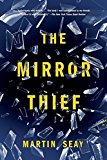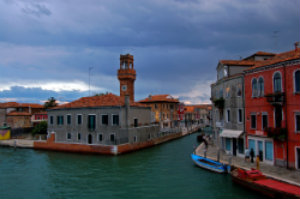Summary | Excerpt | Reading Guide | Reviews | Beyond the Book | Read-Alikes | Genres & Themes | Author Bio

This article relates to The Mirror Thief
The history of Venice begins with the end of the Roman Empire at around 400 A.D. As Roman rule collapsed across Europe groups of Huns, Barbarians and Goths disrupted communities, and on the north-eastern shore of the Adriatic Sea people sought safety from Attila the Hun in the shallow islands of the Venetian Lagoon. With two or three miles of water separating them from mainland Italy, early Venetian settlers were safe from enemies who had no knowledge of seafaring. By 726 A.D. these resourceful people had elected their first doge (duke). Successive doges ruled Venice for the next 1000 years.
In the centuries that followed, Venice became a center for trade, architecture and artistry. Exploiting the seafaring skills of its inhabitants, Venice developed a hugely successful trading empire and business community as well as becoming home to iconic buildings such as the Basilica San Marco and the Doge's Palace. The Republic of Venice survived the threat of the Ottoman Empire in the 16th and 17th centuries but eventually succumbed to Napoleon in 1797 and became an Austrian territory. It finally became part of the Kingdom of Italy in 1866.
 In Martin Seay's novel, The Mirror Thief, Venice in 1592 is accurately portrayed as a powerful Republic: a center for industry populated by alchemists, noblemen, merchants, artisans, intriguers, spies and whores. Crivano, the book's lead character, has a secret enterprise and runs afoul of the Council of Ten, a group with a firm grip on the security of the Republic of Venice, often operating underground and using a network of spies to inform them of dangers to the state.
In Martin Seay's novel, The Mirror Thief, Venice in 1592 is accurately portrayed as a powerful Republic: a center for industry populated by alchemists, noblemen, merchants, artisans, intriguers, spies and whores. Crivano, the book's lead character, has a secret enterprise and runs afoul of the Council of Ten, a group with a firm grip on the security of the Republic of Venice, often operating underground and using a network of spies to inform them of dangers to the state.
As depicted in the novel, the talented mirror makers and glass-blowers of Venice were highly sought after in countries across Europe. The Venetian mirror and glass industry was originally located on the island of Murano, partly to reduce the risk of fire in the main city, but also to keep prying eyes away. In 1592, their factories were allowed to expand beyond Murano and across the islands of the Republic, but a universal ban on migration for all glass-makers was passed at the same time.
 This was still a period of growth for the city and Seay includes among his many descriptions of Venice's streets and canals, the building of the Rialto Bridge that only a few years later would be immortalized in Shakespeare's The Merchant of Venice. Although the bridge had been in existence as a wooden structure since the thirteenth century, in the mid-sixteenth century architects competed to present a design for the stone bridge that is there to this day. Michelangelo, amongst others, submitted a proposal, but the commission was given to Antonio da Ponte. Built with marble, the bridge is formed from two sloped ramps that meet in a central portico to allow large vessels to pass underneath. Completed in 1591, it links the districts of San Polo and San Marco and is one of four bridges over the Grand Canal. In The Mirror Thief, Crivano finds its design "surprising" and "not very classical," although he admits to finding it impressive. Despite contemporary detractors, the bridge is now recognized as a great Renaissance engineering achievement.
This was still a period of growth for the city and Seay includes among his many descriptions of Venice's streets and canals, the building of the Rialto Bridge that only a few years later would be immortalized in Shakespeare's The Merchant of Venice. Although the bridge had been in existence as a wooden structure since the thirteenth century, in the mid-sixteenth century architects competed to present a design for the stone bridge that is there to this day. Michelangelo, amongst others, submitted a proposal, but the commission was given to Antonio da Ponte. Built with marble, the bridge is formed from two sloped ramps that meet in a central portico to allow large vessels to pass underneath. Completed in 1591, it links the districts of San Polo and San Marco and is one of four bridges over the Grand Canal. In The Mirror Thief, Crivano finds its design "surprising" and "not very classical," although he admits to finding it impressive. Despite contemporary detractors, the bridge is now recognized as a great Renaissance engineering achievement.
Antonio da Ponte was also uncle to the builder Antonio Contino, who built another famous Venetian bridge in 1600, the Bridge of Sighs.
Picture of Murano by Aqwis
Picture of Rialto Bridge by Chene Beck
Filed under People, Eras & Events
![]() This "beyond the book article" relates to The Mirror Thief. It originally ran in May 2016 and has been updated for the
April 2017 paperback edition.
Go to magazine.
This "beyond the book article" relates to The Mirror Thief. It originally ran in May 2016 and has been updated for the
April 2017 paperback edition.
Go to magazine.




Judge a man by his questions rather than by his answers.
Click Here to find out who said this, as well as discovering other famous literary quotes!
Your guide toexceptional books
BookBrowse seeks out and recommends the best in contemporary fiction and nonfiction—books that not only engage and entertain but also deepen our understanding of ourselves and the world around us.